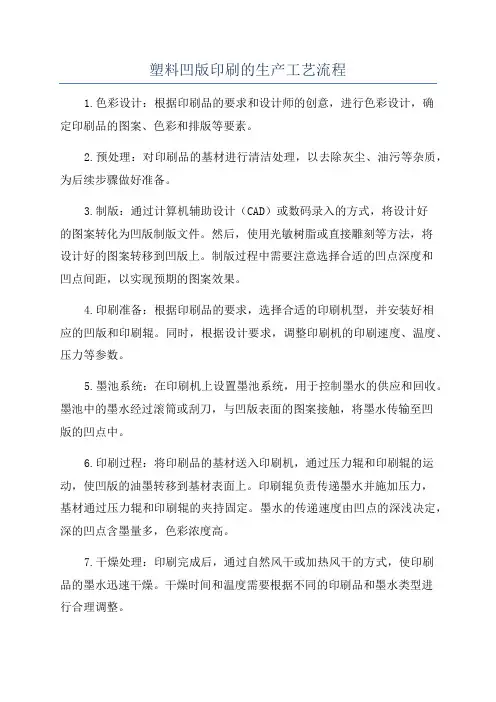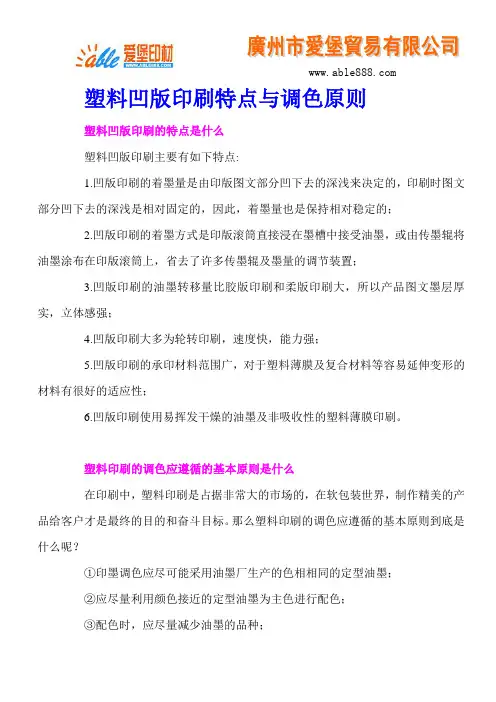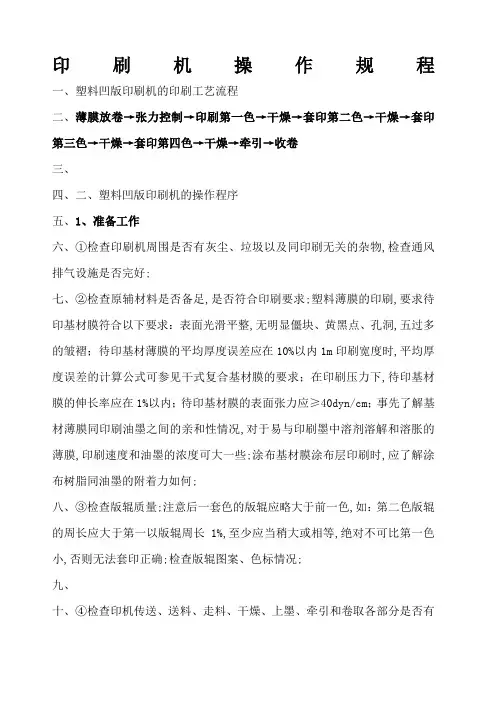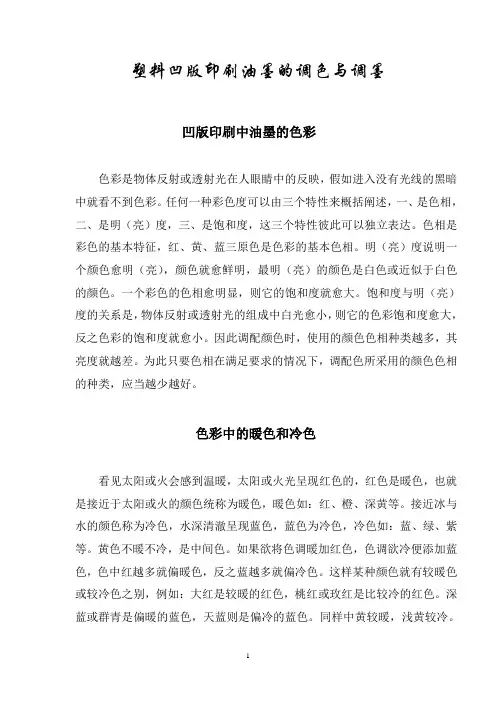塑料凹版印刷
- 格式:ppt
- 大小:6.99 MB
- 文档页数:31

塑料凹版印刷的生产工艺流程
1.色彩设计:根据印刷品的要求和设计师的创意,进行色彩设计,确
定印刷品的图案、色彩和排版等要素。
2.预处理:对印刷品的基材进行清洁处理,以去除灰尘、油污等杂质,为后续步骤做好准备。
3.制版:通过计算机辅助设计(CAD)或数码录入的方式,将设计好
的图案转化为凹版制版文件。
然后,使用光敏树脂或直接雕刻等方法,将
设计好的图案转移到凹版上。
制版过程中需要注意选择合适的凹点深度和
凹点间距,以实现预期的图案效果。
4.印刷准备:根据印刷品的要求,选择合适的印刷机型,并安装好相
应的凹版和印刷辊。
同时,根据设计要求,调整印刷机的印刷速度、温度、压力等参数。
5.墨池系统:在印刷机上设置墨池系统,用于控制墨水的供应和回收。
墨池中的墨水经过滚筒或刮刀,与凹版表面的图案接触,将墨水传输至凹
版的凹点中。
6.印刷过程:将印刷品的基材送入印刷机,通过压力辊和印刷辊的运动,使凹版的油墨转移到基材表面上。
印刷辊负责传递墨水并施加压力,
基材通过压力辊和印刷辊的夹持固定。
墨水的传递速度由凹点的深浅决定,深的凹点含墨量多,色彩浓度高。
7.干燥处理:印刷完成后,通过自然风干或加热风干的方式,使印刷
品的墨水迅速干燥。
干燥时间和温度需要根据不同的印刷品和墨水类型进
行合理调整。
8.后处理:完成干燥后,对印刷品进行裁切、折叠、复合等后处理工序,以获得最终的成品。
9.质检和包装:对印刷品进行质量检验,包括检查图案的完整性、色彩的饱和度和浓度等。
合格的印刷品将被包装起来,待发货或存储。


塑料凹版印刷特点与调色原则
塑料凹版印刷的特点是什么
塑料凹版印刷主要有如下特点:
1.凹版印刷的着墨量是由印版图文部分凹下去的深浅来决定的,印刷时图文部分凹下去的深浅是相对固定的,因此,着墨量也是保持相对稳定的;
2.凹版印刷的着墨方式是印版滚筒直接浸在墨槽中接受油墨,或由传墨辊将油墨涂布在印版滚筒上,省去了许多传墨辊及墨量的调节装置;
3.凹版印刷的油墨转移量比胶版印刷和柔版印刷大,所以产品图文墨层厚实,立体感强;
4.凹版印刷大多为轮转印刷,速度快,能力强;
5.凹版印刷的承印材料范围广,对于塑料薄膜及复合材料等容易延伸变形的材料有很好的适应性;
6.凹版印刷使用易挥发干燥的油墨及非吸收性的塑料薄膜印刷。
塑料印刷的调色应遵循的基本原则是什么
在印刷中,塑料印刷是占据非常大的市场的,在软包装世界,制作精美的产品给客户才是最终的目的和奋斗目标。
那么塑料印刷的调色应遵循的基本原则到底是什么呢?
①印墨调色应尽可能采用油墨厂生产的色相相同的定型油墨;
②应尽量利用颜色接近的定型油墨为主色进行配色;
③配色时,应尽量减少油墨的品种;
④调配浅色墨时,应以白墨为主,少量加入原色油墨;
⑤塑料薄膜是非吸收性材料,不能用稀释剂来冲淡色墨,应加入白墨来冲淡;
⑥不同厂家、不同品种的油墨不能混用.
注:本文来自广州爱堡官方网站,转载请注明!。


塑料凹版印刷机操作流程英文回答:Plastic flexo printing machines, also known as plastic concave plate printing machines, are widely used in the printing industry for printing on various types of plastic materials. As an operator of a plastic flexo printing machine, I am responsible for ensuring the smooth operation of the machine and producing high-quality prints. Here is a step-by-step guide on how to operate a plastic flexo printing machine:1. Preparing the machine: Before starting the machine,I need to ensure that all the necessary materials and tools are ready. This includes the plastic plates, ink, solvent, and cleaning supplies. I also need to check the machine for any mechanical issues or damage.2. Mounting the plates: The first step in the printing process is to mount the plastic plates onto the printingcylinders. I carefully align the plates with the cylinder and secure them in place using adhesive or clamps. This step is crucial for achieving accurate and sharp prints.3. Adjusting the ink: Next, I need to adjust the ink settings on the machine. This includes adjusting the ink viscosity, color density, and ink distribution. I use a spectrophotometer to measure the color density and make any necessary adjustments to ensure consistent and vibrant prints.4. Setting up the substrate: Once the plates and ink are ready, I need to set up the substrate, which is the material on which the printing will be done. This can be a plastic film, paper, or any other suitable material. I make sure the substrate is properly aligned and secured on the machine.5. Running the machine: With everything in place, I can now start running the machine. I carefully control the speed and tension of the substrate to ensure smooth and accurate printing. I also monitor the ink flow and make anynecessary adjustments during the printing process.6. Inspecting the prints: After the printing is complete, I inspect the prints for any defects or imperfections. This includes checking for color accuracy, registration errors, and any other issues. If I find any problems, I make the necessary adjustments and re-run the printing process.7. Cleaning and maintenance: Once the printing job is finished, I clean the machine and remove any residual ink or debris. Regular cleaning and maintenance are essential to keep the machine in good working condition and prevent any issues in future printing jobs.中文回答:塑料凹版印刷机,也称为塑料凹版印刷机,广泛应用于印刷行业,用于在各种塑料材料上进行印刷。


塑料凹版印刷产生刀线原因及解决方法塑料薄膜进行凹版印刷常会出现许多的质量故障,其中产生刀线就是最为常见的故障之一。
刀线的产生使产品报废,易造成经济损失。
作为从事软包装的印刷企业,亟需对其产生原因加以分析总结,并找到相应的解决措施,最终使刀线故障降低到最低点。
一、刀线的产生与油墨粘度的关系刀线的产生与油墨粘度有着直接的关系。
实际生产中,油墨的粘度越高,印刷中越容易产生刀线,这类刀线在印品上大致呈现两种形式。
第一种的刀线呈微细的流丝状,一般不会拖太长,而是间断性地出现在印品上,微细流丝状刀线的起始点大多靠近印刷图案,而且刀线的起始点处一般都比未端粗大一些,在实际生产中若不仔细观察,这种微细的流丝状刀线很容易被忽略。
这种流丝状的刀线往往是造成质量事故的根本原因,必须引起重视。
解决这种流丝状刀线的方法有好几种,这也是印刷员工常用的方法,但也要根据实际情况来定。
a.将一把宽5cm、长15cm、厚140um的软刀片研磨得非常光滑,在出现刀线处轻挑一下,正常情况下,这种微小的流丝状刀线会得到改善的。
这种操作一般在机器运转情况下完成,这就要求必须熟悉操作工来完成,以免容易弄巧成拙,造成不必要的损失。
b.最根本的解决方法则是向油墨中加入适量的相适应的溶剂,以降低油墨的粘度,油墨粘度降低后,细小的流丝状刀线一般都会消除。
这是因为,溶剂加入后油墨粘度降低,流动度相应提高的原故,所以细小的流丝状刀线与流动度变差也相关,这一点须注意。
第二种刀线是以印刷图案为起始点,但刀线集中,而且比较粗糙,并且很有规律地出现在印品的同一位置,往往还要延续到下一色,这种刀线容易被发现。
出现这种刀线的原因是油墨粘度太高,印版上网点转移不良,油墨内助剂随环境温度的变化而遭到破坏,特别是当温度过高时,油墨表面会形成一层薄薄的干固层,时间长了印版与刮墨刀之间积累的墨层就会将刮墨刀顶起,从而产生这种刀线谋。
解决这种刀线方法是,首先调整刮墨刀角度,一般情况下,刮墨刀与印版之间的角度为60°,但有些时候可将刮刀与印版的角度增大到65°左右,这样刮墨刀的压力也相应增大了。

印刷机操作规程一、塑料凹版印刷机的印刷工艺流程二、薄膜放卷→张力控制→印刷第一色→干燥→套印第二色→干燥→套印第三色→干燥→套印第四色→干燥→牵引→收卷三、四、二、塑料凹版印刷机的操作程序五、1、准备工作六、①检查印刷机周围是否有灰尘、垃圾以及同印刷无关的杂物,检查通风排气设施是否完好;七、②检查原辅材料是否备足,是否符合印刷要求;塑料薄膜的印刷,要求待印基材膜符合以下要求:表面光滑平整,无明显僵块、黄黑点、孔洞,五过多的皱褶;待印基材薄膜的平均厚度误差应在10%以内1m印刷宽度时,平均厚度误差的计算公式可参见干式复合基材膜的要求;在印刷压力下,待印基材膜的伸长率应在1%以内;待印基材膜的表面张力应≥40dyn/cm;事先了解基材薄膜同印刷油墨之间的亲和性情况,对于易与印刷墨中溶剂溶解和溶胀的薄膜,印刷速度和油墨的浓度可大一些;涂布基材膜涂布层印刷时,应了解涂布树脂同油墨的附着力如何;八、③检查版辊质量;注意后一套色的版辊应略大于前一色,如:第二色版辊的周长应大于第一以版辊周长1%,至少应当稍大或相等,绝对不可比第一色小,否则无法套印正确;检查版辊图案、色标情况;九、十、④检查印机传送、送料、走料、干燥、上墨、牵引和卷取各部分是否有卡阻现象,润滑部分注入润滑油,油路是否顺畅,仪器仪表是否完好;如设备上有油墨黏度自动控制仪的话,应调节印刷油墨的黏度在14~18s的设定值上,并在其中倒入混合溶剂,同墨槽用墨泵相连接;检查电脑自动对版装置;十一、⑤调配好油墨,选择同打样色标一样的原色油墨;十二、十三、2、装版十四、装版时要注意版子的左右面,卡紧锥体时不能过紧,防止把铜版辊胀裂,过松,印刷时会“逃版”;按照印刷色序来安装版辊;里印刷的印刷色序是金银墨→黑墨→原青→原黄→原红→白墨;正印刷时刚好相反:白墨→品红墨→黄墨→青墨→黑墨→金银墨;十五、十六、3、上刮墨刀十七、刮墨刀一般采用薄钢片,厚度在~之间;刮墨刀同印辊接触点切线之间的角度在15°~45°之间,小于15°,油墨不易刮净;大于45°,对印版和刮刀的损伤都比较重,易把印版镀铬层刮坏;刮墨刀压力不易过大,太大,易损坏印版;过小;不易刮净油墨;刮墨刀使用旧了的时候,可以用280~400目油石,从左向右均匀地沾上机油研磨,或者用800目以上金相砂皮纸沾上机油把刮墨刀连同刀架一起卸下后夹在夹具上均匀研磨,防止刮刀伤害人的手指; 十八、十九、刮墨刀与硬刀衬片重叠后置于上下夹持板中间,用螺栓栓紧;操作时螺栓要从中间向左右两端对称的拧紧,以免刀片弯曲;刮墨刀伸出硬刀衬片的长度为10~20mm,伸出长度过长,刮墨刀柔软,不易刮清;过短,刚性增加,刮擦太大,易损刀损版;硬刀衬片厚度易为~;二十、二十一、4、开机印刷二十二、凹版轮转机,一般采用无极变速系统控制印刷速度,为了使各色印刷单元同步,采用一个主电机和无级变速器,用一根长的转动轴带动整个印刷系统;开动墨泵,检查墨泵是否倒转;在各色印版离合器脱离的状况下启动主电机,检查变速器变速情况,然后开干燥器和鼓风机,在低速下合上离合器,进行套色;以第一色为基准,启动点动开关进行第二、第三、第四的纵向套色校准;然后仍以第一色为基准,进行第二、第三、第四色横向套色对准,横向的套色用手轮微调对准;纵横向套色对准后,加快印刷速度;如没有全自动电脑对版装置的,则印刷速度无论是卫星式轮转机还是组合式轮转机,不要超过40m/min;超过40m/min,肉眼无法跟踪观察,一般控制在25~30m/min即可;操作工人应密切注意套色情况,随时手工调节;如有全自动电脑对版装置,则应把操作模式打在自动对版上,这时,电脑能自动跟踪,发现偏离情况,会自动发出纠正信号,使版辊或基材移动,重新对准;二十三、二十四、在进口设备上,有一加热辊,待印基材放卷后,使基材能加热到50℃左右,然后进入第一色印刷单元;基材温热有利于印刷油墨的粘附力的提高和干燥;涂上油墨后,油墨进入干燥器,干燥器温度的排布以低-高-低的形式设定,便于快速干燥;不能印刷后立即进入高度干燥,这样容易使油墨层表面结成一层膜,组织里面溶剂的挥发干燥,结果印刷品干燥不够,堆放中易反粘;二十五、二十六、印刷基材不同张力控制不同;对BOPP膜而言,每米宽度的张力控制设定在5~8kgf49~较好,双向拉伸尼龙薄膜的印刷张力控制在~98N,而双向拉伸PET薄膜的印刷张力控制在98~;如果不足1米宽,则乘上其宽度同1m的比值即可,如;则上述张力乘即可;当印刷已经吸湿了的尼龙薄膜时,会发生印墨附着力下降和印刷边缘往外溢墨的现象,这时,可将第一色的干燥器打开,再把第一色版辊放在第二色位置上,各色后移一个单元;第一色就成了尼龙薄膜干燥位置,干燥温度可设定在80~90℃;二十七、二十八、5、印刷结束后的工作印刷任务完成后停止主电机,印刷基材停止给料;压印辊提升,刮刀脱离印刷版面,停止墨泵,倒出剩余油墨,清洗印版表面,直到无残留印墨,取下已印刷了的基材,关闭干燥器电加热,清洁地面;当印版不再使用时,把印版卸下,两端架起,放在专用的印版架上;如长期不用,则包好放置在仓库;一组印辊应放在一起,避免搅乱,外面要贴上标签,并注明了已印刷了多少印次,以备随时使用;。



安徽新闻出版职业技术学院毕业实践报告题目:新合发(平湖)凹印包装系部:印刷工程系 __________________ 专业:印刷设备及工艺 _______________ 班级:印刷设备及工艺一班学生姓名:送遴 _____________________ 学号:D1******* _______________指导老师:陈旭东 ___________________二0 —四年五月五日摘要 (1)一、刖舌 (1)二、印刷工艺流程 (2)(-)准备工作 (2)(二)............................................... 版轨的核对2(三)..................................................... 装版3(四)................................................. 上刮墨刀3(五)................................................. 印前准备4(六)................................................. 正式印刷4(七)......................................... 软包装凹版印刷机5三、复合加工 (5)四、制袋工序 (6)(一)................................................. 生产准备7(二)........................................... 开机前准备工作7(三)................................................. 开机生产8(四)......................................... 操作者应注意事项8(五)......................................... 制袋机的清洁保养8五、总结.. (9)参考文献 (10)致谢 (10)新合发(平湖)凹印包装摘要凹版印刷作为一种重要的印刷技术,有着广阔的发展前景,在国内外都得到了广泛的应用。
塑料凹版印刷机操作流程英文回答:Operating a plastic flexographic printing machine involves several steps. Here, I will walk you through the process in detail.1. Preparing the machine: Before starting the printing process, it is essential to ensure that the machine is set up correctly. This includes checking the ink levels, adjusting the pressure settings, and making sure the printing plates are securely attached to the cylinders.2. Loading the material: The next step is to load the plastic sheets or rolls onto the machine. This can be done by feeding the material through the machine's rollers or by attaching the rolls to the unwind stand. It is crucial to ensure that the material is aligned properly to avoid any misprints.3. Adjusting the settings: Once the material is loaded, it is necessary to adjust the machine settings according to the desired print specifications. This includes setting the printing speed, adjusting the ink viscosity, and selecting the appropriate color settings.4. Printing: With the machine properly set up, it is time to start the printing process. The machine will automatically feed the material through the printing unit, where the inked plates transfer the design onto the plastic surface. The printed material then passes through a drying unit to ensure the ink sets properly.5. Quality control: Throughout the printing process, it is crucial to monitor the print quality. This involves inspecting the printed material for any defects, such as smudges or misregistrations. If any issues are detected, adjustments can be made to the machine settings to rectify them.6. Finishing: Once the printing is complete, theprinted material can undergo additional finishing processes,such as laminating, cutting, or folding, depending on the specific requirements of the job.7. Cleaning and maintenance: After the printing job is finished, it is essential to clean the machine thoroughly to remove any ink residue or debris. Regular maintenance, such as lubricating moving parts and replacing worn-out components, should also be performed to ensure the machine's optimal performance.中文回答:操作塑料凹版印刷机涉及几个步骤。
塑料凹版印刷机操作流程英文回答:Operating a plastic gravure printing machine involves several steps to ensure smooth and efficient printing. Here is a step-by-step guide on how to operate a plastic gravure printing machine:1. Preparing the machine: Before starting the machine,I need to ensure that it is properly set up and ready for operation. This includes checking the ink levels, adjusting the printing plates, and ensuring that all the necessary tools and materials are in place.2. Loading the substrate: I will need to load the plastic sheets or films onto the machine's feeding system. This can be done manually or with the help of an automatic feeding system, depending on the machine's capabilities.3. Adjusting the printing parameters: Once thesubstrate is loaded, I will need to adjust the printing parameters such as ink viscosity, printing speed, and pressure. This is crucial to achieve the desired print quality and to prevent any issues such as smudging or ink bleeding.4. Printing the test sample: Before starting the actual production run, it is important to print a test sample to ensure that everything is set up correctly. This allows meto make any necessary adjustments before printing the final product.5. Starting the production run: Once the test sample is approved, I can start the production run. This involves continuously feeding the substrate into the machine, while the printing cylinders transfer the ink onto the plastic surface. I will need to monitor the printing processclosely to ensure that everything is running smoothly.6. Inspecting the printed product: As the productionrun progresses, I will need to periodically inspect the printed product to check for any defects or inconsistencies.This can be done visually or by using specializedinspection tools.7. Finishing and packaging: Once the printing is complete, I will need to remove the printed plastic sheets from the machine and prepare them for further processing or packaging. This may involve cutting, trimming, orlaminating the printed sheets, depending on the specific requirements.8. Cleaning and maintenance: After the production run,I will need to clean the machine thoroughly to remove any residual ink or debris. Regular maintenance is also important to keep the machine in optimal condition and prevent any breakdowns or malfunctions.中文回答:操作塑料凹版印刷机涉及多个步骤,以确保印刷过程顺利高效。
《塑料凹版印刷中静电的危害和消除、防护措施》静电的电容量虽然很小,但电压很高,因此在爆炸和火灾危险场所,高电阻材料上产生的静电电荷,当对导体或空气进行放电时,会导致危险的火花放电,而引起爆炸事故。
据统计,在塑料凹版印刷行业几乎每年都有因静电而引起的设备损坏或人员伤亡事故。
静电的危害已经是该行业潜在的重大危害源。
一、静电的产生:实验证实,不仅仅是摩擦时能够产生静电,只要两种物质紧密接触而后再分离时,就会产生静电。
在印刷过程中,由于塑料薄膜于导辊、压印辊、版辊之间的摩擦,膜卷收放过程中的接触分离,油墨、溶剂的转移、流动等都会产生静电。
1、在印刷、复合生产过程中易产生的静电。
(1)塑料印刷、复合时与辊轴、橡胶压辊的摩擦;(2)印刷放卷或收卷时,膜卷剥离和卷取的摩擦;(3)传动皮带与皮带轮之间的摩擦;(4)油墨或溶剂在油墨管道中流动造成的摩擦;(5)压缩气体在管道中流动或由管口喷出造成的摩擦;(6)操作人员在拉放膜卷、搬运油墨时的摩擦;2、静电产生的影响因素:(1)静电的产生和积累受材质的影响。
材料的表面电阻率对于静电泄漏有很大影响。
只有轻易得失电子,而且电阻率很高的材料才轻易产生和积累静电。
凹版印刷常用的材料中比较轻易产生静电积累的有甲苯、PVDC膜、尼龙膜等。
(2)静电的产生受生产工艺设备的影响。
由于静电的产生主要是靠摩擦,因此物体之间的摩擦接触面积越大,接触面的越粗糙,接触面之间的压力越大,接触面的滑动或流体的流速越快,形成的摩擦越大,产生的静电也越大。
在印刷、复合工序,由于印刷或复合的压印辊和印版之间的接触压力大,和印刷薄膜之间的包角大,接触面多,在高速印刷的条件下,是最轻易产生静电的部位。
若该处的静电不能及时消除,就会造成静电积累,造成静电火花放电,极易造成油墨、溶剂的燃烧或爆炸。
这也是塑料凹版印刷企业安全防护的重点。
(3)静电的产生受环境湿度的影响。
材料表面电阻率随空气湿度增加而降低,相对湿度越高,材料表面电荷密度越低。
新闻网页贴吧知道MP3图片视频百科文库凹版印刷百科名片凹版印刷是图像从表面上雕刻凹下的制版技术。
一般说来,采用铜或锌板作为雕刻的表面,凹下的部分可利用腐蚀、雕刻、铜版画或mezzotint金属版制版法,Collographs可能按照凹印版印刷。
要印刷凹印版,表面覆上油墨,然后用塔勒坦布或报纸从表面擦去油墨,只留下凹下的部分。
将湿的纸张覆在印版上部,印版和纸张通过印刷机加压,将油墨从印版凹下的部分传送到纸张上。
目录定义发展要素1. 原稿2. 油墨3. 印版4. 承印物5. 印刷机械特点1. 防伪2. 范围广3. 印刷质量高4. 大批量印刷工艺1. 印前准备2. 上版3. 调整规矩4. 正式印刷种类1. 雕刻凹版2. 腐蚀凹版应用优劣控制问题趋势定义凹版印刷简称凹印,是四大印刷方式其中的一种印刷方式。
凹版印刷是一种直接的印刷方法,它将凹版凹坑中所含的油墨直接压印到承印凹版印刷原理图物上,所印画面的浓淡层次是由凹坑的大小及深浅决定的,如果凹坑较深,则含的油墨较多,压印后承印物上留下的墨层就较厚;相反如果凹坑较浅,则含的油墨量就较少,压印后承印物上留下的墨层就较薄。
凹版印刷的印版是由一个个与原稿图文相对应的凹坑与印版的表面所组成的。
印刷时,油墨被充填到凹坑内,印版表面的油墨用刮墨刀刮掉,印版与承印物支一定的压力接触,将凹坑内的油墨转移到承印物上,完成印刷。
凹版印刷作为印刷工艺的一种,以其印制品墨层厚实,颜色鲜艳、饱和度高、印版耐印率高、印品质量稳定、印刷速度快等优点在印刷包装及图文出版领域内占据极其重要的地位。
从应用情况来看,在国外,凹印主要用于杂志、产品目录等精细出版物,包装印刷和钞票、邮票等有价证券的印刷,而且也应用于装饰材料等特殊领域;在国内,凹印则主要用于软包装印刷,随着国内凹印技术的发展,也已经在纸张包装、木纹装饰、皮革材料、药品包装上得到广泛应用。
当然,凹版印刷也存在局限性,其主要缺点有:印前制版技术复杂、周期长,制版成本高;由于采用挥发型溶剂,车间内有害气体含量较高,对工人健康损害较大;凹版印刷从业人员要求的待遇相对较高。